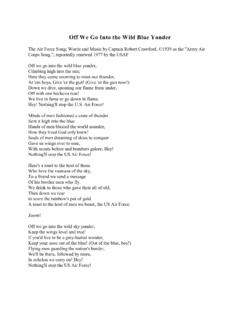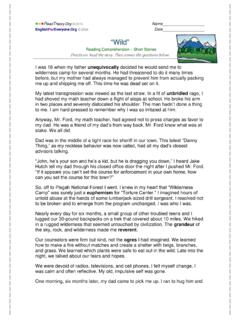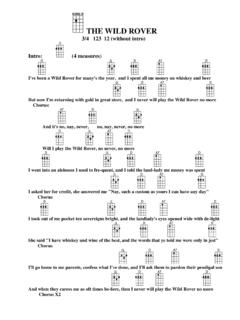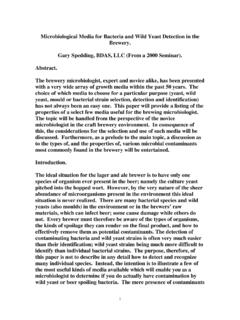Transcription of Annex 2 Guidelines for the safe production and quality ...
1 World Health Organization WHO Technical Report Series, No. 926, 2004. Annex 2. Guidelines for the safe production and quality control of inactivated poliomyelitis vaccine manufactured from wild polioviruses (Addendum, 2003, to the Recommendations for the production and quality Control of poliomyelitis vaccine ( inactivated )). The WHO Recommendations for the production and Qual- ity Control of poliomyelitis vaccine ( inactivated ) were last revised in 2000. At that time it was envisaged that the pro- duction and quality control of inactivated poliomyelitis vaccine (IPV) manufactured from wild poliovirus strains should, in the near future, comply with more stringent biosafety conditions.
2 This was because of the context of an increasingly polio-free world and the need for effective con- tainment of wild poliovirus strains as a pre-condition of global certification of polio eradication. These Guidelines specify steps to be taken to minimize the risk of reintroducing wild poliovirus from a vaccine - manufacturing facility into the community after global certification of polio eradication. Each of the following sec- tions constitutes guidance for national regulatory authori- ties and for the manufacturers of inactivated poliomyelitis vaccine . If a national regulatory authority so desires, these Guidelines may be adopted as definitive national require- ments, or modifications may be justified and made by a national regulatory authority.
3 It is recommended that modifications to these Guidelines be made only on condi- tion that the modifications ensure that the risks of reintro- ducing wild poliovirus to the community are no greater than as outlined in the Guidelines set out below. 65. 1. Introduction 66. Glossary 68. 2. Biosafety implementation within a vaccine production facility 72. 3. Personnel 73. 4. Premises and equipment 75. General requirements 75. Security access control 76. Primary containment barriers 76. Secondary containment barriers 77. Sterilization and waste disposal systems 79.
4 5. Documentation and validation 80. 6. production 81. Personal protection and equipment 82. Polio strains for biosafety level-3/IPV containment 83. 7. quality control 84. 8. Emergency procedures 86. Authors 88. Bibliography 88. 1. Introduction In May 1999 the World Health Assembly reaffirmed the commitment of the World Health Organization (WHO) to eradicating poliomyeli- tis and urged all member states to begin the process leading to the containment of stores of wild poliovirus. In December 1999, after consultation with scientists, ministries of health and vaccine manufac- turers worldwide, WHO published the WHO global action plan for laboratory containment of wild polioviruses.
5 A second edition of the Global Action Plan published in 2003 replaces the first. The purpose of the plan was to identify steps that all countries should take to minimize the risk of reintroducing wild poliovirus from a laboratory or vaccine production facility into the community after polio eradica- tion. The plan calls for materials infected or potentially infected with poliovirus to be handled and stored under biosafety conditions appro- priate to their risk; implementation of these containment levels world be a requirement for the certification of eradication.
6 For facilities such as IPV manufacturers, where infectious materials come into contact with permissive cells or animals, high containment (Biosafety level (BSL-)3/IPV) measures are required. Biosafety level-3/IPV requires the primary and secondary contain- ment of infectious materials containing wild poliovirus, with provi- 66. sions governing air, water and materials entering and leaving the facility, specific requirements for personal protective clothing, labora- tory design, the use of laboratory equipment and medical surveillance of laboratory staff. Additionally it requires vaccination of all staff against polio, appropriate training in biosafety procedures, and vali- dation and documentation of the physical and operational require- ments.
7 Implementation of such containment provisions within IPV. production and quality control testing facilities must also take into account the large quantities and concentrations of live vaccine that are produced, the industrial scale of facilities, and the existing rules and regulations governing the manufacture and testing of medicinal products, generally known as good manufacturing practices (GMP). The control of contamination is a major concern in both biosafety and GMP. Whereas GMP prioritizes the safety of the patient being treated with the medicinal product, biosafety focuses on the protec- tion of the personnel and the surrounding environment.
8 These con- cepts are not mutually exclusive, and a considerable area of overlap exists between the two. It may not always be possible for facilities and procedures to meet the ideal situation as seen from both GMP and biosafety perspectives, and some degree of flexibility may be required to satisfy both objectives. A number of the internationally harmo- nized GMP Guidelines , such as those of WHO or the European Union, have introduced specialized GMP requirements for biological products. The requirements for IPV producers in the post-eradication era should be viewed as a special addendum to be read with these GMP Guidelines .
9 It would apply in the exceptional case where a licensed medicinal product must be manufactured and tested within a large-scale containment facility, when, through the combined efforts of many partners, the disease for which the vaccine has been used has been eliminated globally. This document addresses the period after the interruption of wild poliovirus circulation. At that time, natural immunity acquired as a result of contact with wild poliovirus will start to decline, but immuni- zation coverage is anticipated to remain at levels adequate to protect both individuals and communities.
10 During this period, the implemen- tation of large-scale BSL-3/IPV containment measures will provide sufficient barriers against the accidental release of poliovirus from vaccine manufacturing facilities into the environment. If polio immu- nization is discontinued in some or all countries after global certifica- tion, containment requirements for wild viruses or attenuated viruses used in OPV will need to be reconsidered and may become more stringent, to deal effectively with the consequences of inadvertent transmission of wild poliovirus from the laboratory or vaccine 67.















